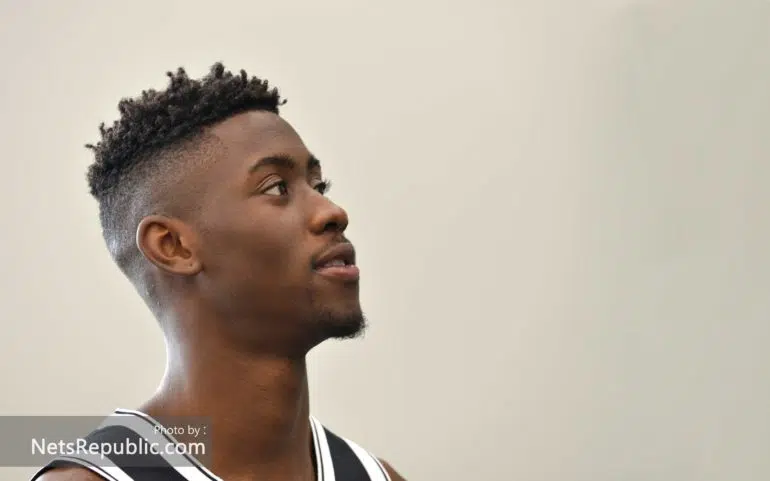Brooklyn Nets guard/forward Caris LeVert has done a strong job turning his immense talent into production lately. Let’s break down his recent play with video.
Take a look at this play from the Nets-Hornets game on February 22nd.
With ten seconds left on the shot clock, Caris LeVert attacks Charlotte forward PJ Washington by taking about 15 dribbles into a contested fade-away that clanks off the rim.
The play was obviously insignificant in a game the Nets ended up winning 115-86, but it was emblematic of Caris LeVert’s offensive game at the time. He went 7-19, shot zero(!!) free throws, and only recorded two assists. In the prior two games, he had combined to shoot 19/49.
LeVert’s shot diet was too saturated with this type of shot attempt, where he makes a bunch of hesitation dribbles and fakes but still ends up shooting the ball 15 feet from the basket. The mid-range pull-up, existing in dead zone of modern basketball’s ideal shot diet, becomes an even lower percentage gamble when it comes after that many isolation dribbles. This made it hard to trust LeVert when the Nets offense needed a clean look.
When Caris LeVert, a week later, took over late in Boston to score 51 points, his offensive game looked rejuvenated entirely, as he also put up 5 assists despite going a healthy 17-26 from the field.
Take a look at this drive by LeVert in the mid-stages of Brooklyn’s comeback. He calmly sizes up a bigger, slower defender in Grant Williams, and decides he isn’t going to settle, blowing right by the rookie. No need to try to put him in the blender.
Caris LeVert didn’t just punish bigs-on-switches though. On the the next possession he went right by A-grade perimeter defender Marcus Smart with a simple change of direction and downhill take. Caris LeVert would end up shooting 18 free throws vs. Boston. Every high-level scorer in the league shares one trait, and it’s the ability to get those free points. It’s hard to accomplish that if you don’t attack the rim consistently.
Even up 6 in OT, LeVert kept forcing the issue; here he takes it to the body of Carsen Edwards, who has no hope as a small guard to get his hands in there, and LeVert gets another two free throws. Compare that drive to this one, vs. the undersized Devonte Graham, that ends in a tough fadeaway:
The five assists Caris LeVert tallied too were a result of his aggressive mentality he had vs. the Celts.
LeVert’s offensive game is much more well-rounded when he attacks the rim under control: Here, one behind-the-back dribble is enough to get by the first defender, and an on-balance euro-step lets him set up TLC for an easy knockdown three. When LeVert can survey the floor on under-control drives, help defense is reluctant to commit until it is too late:
There are two things that stand out about this play, which sometimes go missing from Caris’ offensive game. First, he attacks Brad Wannamaker directly; his momentum never stops going north-to-south during his crossover dribbles. Then, he chooses to elevate into the body of a larger defender, instead of fading away from the rim. LeVert’s potential as a fringe All-Star scorer shines through on plays like these, where he uses both his quick handles and explosive 6’5″ frame well.
As is typical of the post Morey-ball NBA, a lot of this depends on how Caris LeVert is shooting from 3. In Boston, he kept Brad Stevens’ defense more than honest by going 5-10 from three. In LeVert’s last five games, he is shooting 40.6% from three, which includes a Curry-esque 43.6% on pull-up threes. This is obviously due for some regression, but it does carry some weight: LeVert is making more threes because he has operated entirely his pace since his explosion in Boston. It’s a similar adjustment to what Celtics star Jayson Tatum is making right now, as he blossoms into a 25-a-night scorer shooting the lights out from three.
However, there’s still improvements to be made in LeVert’s game, which could indicate a role for him on next year’s Brooklyn Nets team led by Kyrie Irving and Kevin Durant. He won’t be able to dribble the ball and attack this much, but the numbers show he could do well in a role where pounding the rock is less required.
This year, 41.3% of LeVert’s shots have come off 7+ dribbles. Because he isn’t James Harden, those shots produce the worst results for LeVert. His eFG% is a lowly 40% on those type of attempts. To shoot that many shots with that efficiency will lead to the type of 7-19 night he had in Charlotte. All his other splits, though, jump off the page. After 3-6 dribbles, LeVert has an eFG% of 68.5 After 1-2 dribbles, that number jumps to 78%.
When Caris LeVert doesn’t aimlessly dribble the ball, his scoring ability jumps immensely. His three-point catch and shoot percentage of 30.3% will need to improve by next year, but the rest of his game is there. The fact that LeVert hits 43.0% of off-the-dribble threes confirms his shot is NBA-quality, and he attacks the basket as well as anyone when he is decisive about it. For LeVert, his offensive talent is unquestionable, it’s just a matter of utilizing it properly.

